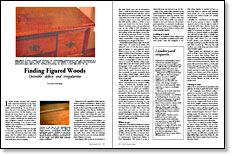
Synopsis: To learn how to work figured wood, Lane DeCamp researched the mill business and talked to professional cabinetmakers about how they built their wood stashes. Here he shares information on maple, since that’s what he uses most. He advises going where the trees are to buy lumber, and he offers advice on looking at a stack and how to cart your selections away. The article includes descriptions and photos of figured woods, such as soft curly maple, hard curly maple, blistered and quilted maple, bird’s-eye maple, and worm scars. Side information covers lumberyard etiquette.
I build mostly Colonial and Federal style American furniture in my shop, most of it in figured woods, with maple predominating. On my first projects, I’m sure I was paying well north of $20 per board foot for this lumber, even though the price sheets at the mills said $2.50 or less. Yield was awful. I was picky, and I couldn’t reliably get the quality and type of figure I wanted. In those days, I ended up burning a lot of poor curly maple in my woodstove as I balanced my checkbook in disgust.
Since then, I’ve been fortunate enough to become acquainted with several mill owners who showed me their side of the game, and I’ve talked with a number of professional cabinetmakers about how they built their own woodpiles.
Figured woods, regardless of the species, share a family resemblance. What is true for identifying a spectacular board of curly maple in the rough will generally hold true for identifying curly cherry, fiddleback walnut, quilted mahogany or any other figured wood. This being the case, I’ve chosen to discuss maple because that’s the wood I use the most.
Regardless of wood technologists’ or furnituremakers’ distinctions, most mills distinguish only between hard maple and soft maple and then get pretty fuzzy about what is curly, fiddleback or even quilted. Nature didn’t draw clear distinctions, so the mills don’t either. Still, by learning what to look for, you can end up with the kind of figure you want.
Most figure only occurs in wood close to the bark (bird’s eyes are an exception). Thus, a wide board whose center comes from deep inside the tree will have curl on the sides but not in the middle. A tree will only yield a few wide boards with superb, consistent figure across their width, and the mill usually collects a dollar or two more per board foot for those boards. They’re worth the extra cost, provided you can use the width to full advantage. If you’re going to end up trimming the edges and cutting off the best figure, you’re better off buying narrower boards or boards in which the figure is interrupted. You’ll enjoy considerable savings without compromising your design in the least.
From Fine Woodworking #99
For the full article, download the PDF below:
Fine Woodworking Recommended Products

DeWalt 735X Planer

AnchorSeal Log and Lumber End-Grain Sealer

Ridgid R4331 Planer




















Log in or create an account to post a comment.
Sign up Log in